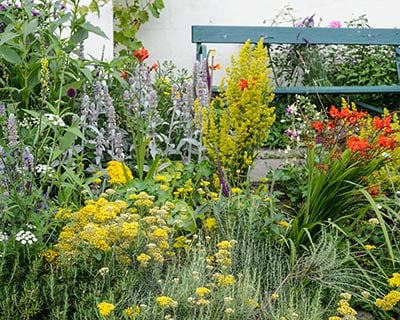Creating a border to attract wildlife
When creating a perfect pollinator border, ask yourself what type of wildlife and pollinators you’d like to see more of in your garden
There’s nothing quite as captivating as stopping to count how many different species of insects are attracted to a single plant. As gardener designers, we want to attract as large a range of interesting insects and other buzzing busy bodies as we can get our hands on, into our own gardens. Choosing a good range of plants will help achieve a bustling hub of activity.
Plants for attracting pollinators
Selecting the right spot to create the border is the second most important thing, as different pollinators need different environments to thrive. A warm and sunny patch of your garden is a great place to start. We’ve chosen a selection of plants that love full sun and moist well-drained soil. Once established, the border will eventually need little maintenance.
- Salvia nemorosa ‘Caradonna’
- Foeniculum vulgare ‘Purpureum'
- Verbena bonariensis
- Geranium psilostemon or Geranium ‘Blue Cloud’
- Nepeta racemosa ‘Walker's Low’
- Allium sphaerocephalon
- Thymus ‘Fragrantissimus’
Stand out plants in the border
A hero plant for attracting pollinators is salvia of any shape or variety. You can’t go wrong with planting Salvia nemorosa ‘Caradonna’ with its upright regal purple spires. Bees adore the masses of tiny vibrant, violet-blue flowers, which offer a nectar-rich feast for many other pollinators too. Salvia flower freely from May to July and a great way of extending their season is by giving them a ‘Chelsea-chop’ meaning to prune back at the end of May. A great alternative is Salvia ‘Nachtvlinder’, which will become drought tolerant once established, making it a good choice if you’re a slightly neglectful gardener.
What are pollinators looking for?
Hoverflies are mesmerising as they appear to float in the air, wings flapping so quickly you can hardly see them. They adore the tiny yellow flowers of Foeniculum vulgare ‘Purpureum’ (bronze fennel). Umbellifers, like fennel, have broad flowerheads composed of lots of small flowers with nectar that can be easily accessed. Honeybees are also fond of the flowers. They’re easy to grow, doing best in a sunny spot with well-drained soil. They also look a real treat early on in the season, providing a mass of fluffy purple foliage which looks fantastic against the purple spires of the Salvia nemorosa ‘Caradonna’. Just because it’s good for wildlife, doesn’t mean you can’t admire it too!
The best of the blues
A really great choice of colour for wildlife is anything with a blue flower head. Try plants such as Michaelmas daisies, Geranium ‘Blue Cloud’ or Nepeta racemosa ‘Walker’s Low’. Leave the seed heads on the plants over winter, as they offer a valuable source of food as well as somewhere for insects to shelter over the colder months.
